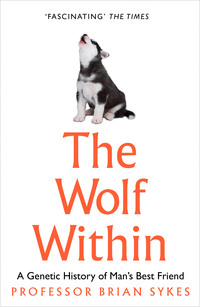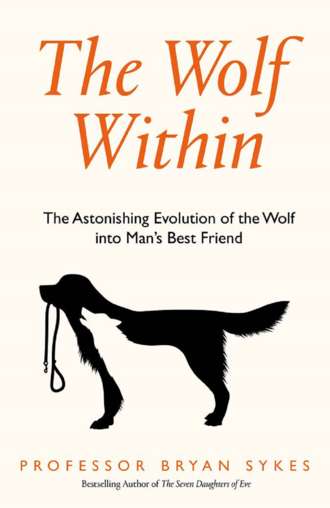
Полная версия
The Wolf Within: The Astonishing Evolution of the Wolf into Man’s Best Friend
Reaching into the ribcage of the fallen aurochs, the younger man ripped out its still-beating heart and tossed it towards the wolves, much to the dismay of his older companion. Still the wolves stayed where they were, their amber eyes fixed on the humans. After a full five minutes Lupa was the first to move, gingerly advancing towards the offered heart. The other wolves watched in silence. Lupa sniffed at the heart, then opened her wide jaws and sliced off a chunk of the left ventricle and began to eat it. Still the others did nothing. After a further five minutes, with an almost imperceptible movement of her ears Lupa sent a silent signal to the rest of her pack. They advanced and tore the rest of the heart to shreds.
When both wolves and humans had gorged themselves on the beast’s entrails they sat there looking at each other. Something passed between them. Was it a spirit message? Was it merely mutual admiration between hunters? Did either of them know what had just happened?
Over the years that followed, wolf and human grew closer together. The next spring, as lines of reindeer moved towards the skyline through purple meadows of crocus and gentian on their way to summer pastures, wolf and human followed to pick off the stragglers. Increasingly easy in each other’s company, they no longer kept their distance and it was not long before they began to cooperate in the hunt. Sensing a weakness among the reindeer, Lupa picked out the target animal in the herd. The pack trotted off in pursuit, with the humans following as best they could. As the isolated deer began to tire, the wolves formed a circle and held it at bay until the humans arrived to kill it with their spears. Because the wolves no longer needed to completely exhaust the animal in order to avoid injury, the chase was over more quickly. For their part, the humans had a static target for their spears. All shared the kill.
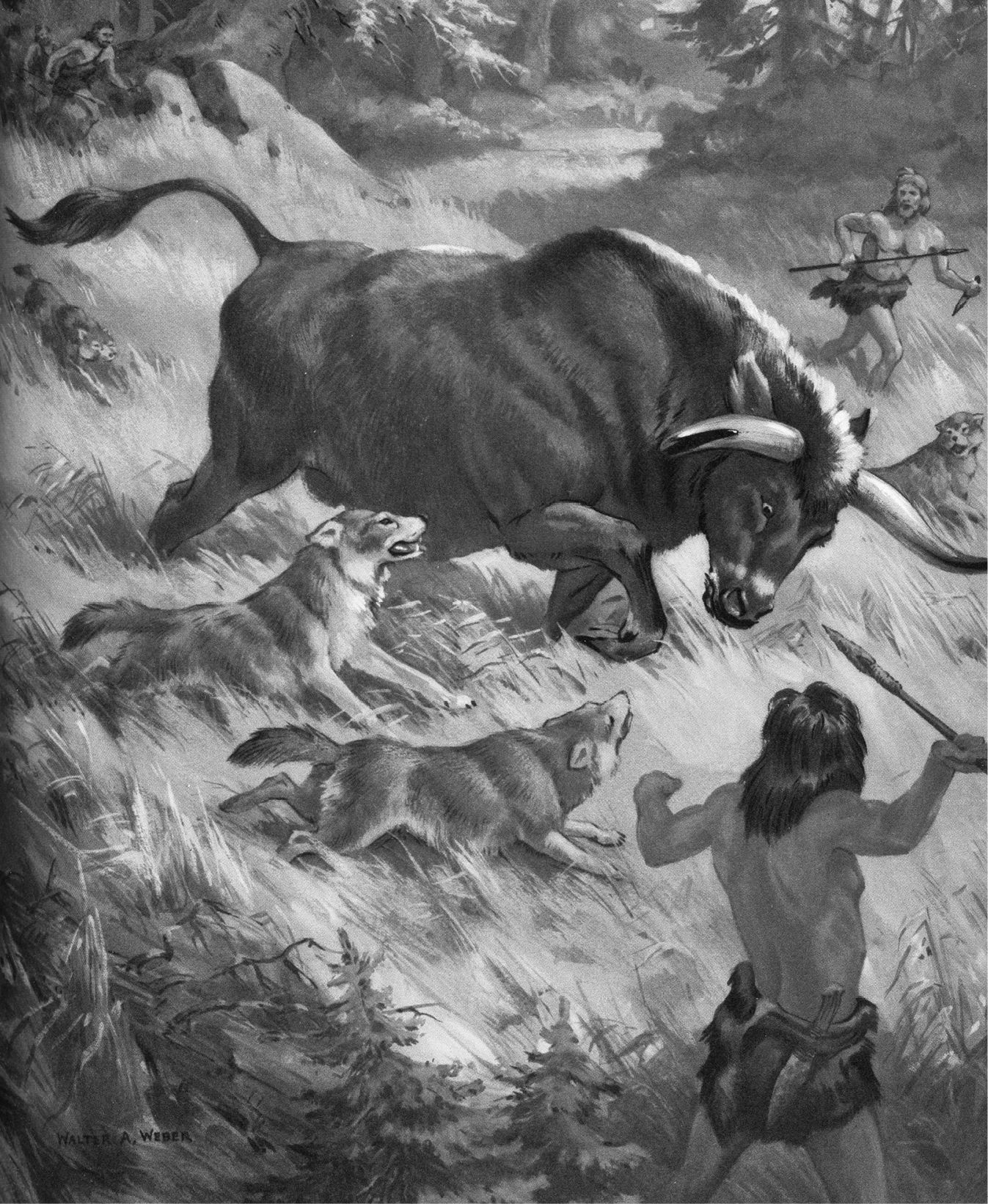
An Artist’s recreation of what a collaborative hunt, like Lupa’s, might have looked like. The wolves harry the aurochs, tiring it out, while the humans inflict the killing wounds from a safe distance. (© GraphicaArtis)
Wolf and human benefited from this collaborative hunting, and in the years that followed, long after Lupa had died, both groups learned to adapt and improve it. Wolves began to signal the presence of prey with a low-pitched howl. Humans understood the message and a hunting party set out to join them. Wolves and humans who hunted together prospered at the expense of those who did not. Their numbers increased and gradually the unstoppable current of natural selection spread this symbiosis across the rest of Europe. Eventually some wolves began to live with humans, intermittently at first, then permanently. Their numbers increased even more and, from this beginning, dogs began to evolve.
All this happened a very long time ago in the high and wild country above the Gate of Trajan. That was the start. We have yet to reach the end.
* Named after Roman Emperor Trajan (ruled 98–117 CE) and marking the northern boundary of the Empire.
2
Darwin’s Dilemma
It’s easy to pinpoint the moment when the collective view of how humans and all other animals and plants came to be changed abruptly. On 24 November 1859 the naturalist Charles Darwin published On the Origin of Species by Means of Natural Selection. The main contention of the book, that species were not fixed and could change over time, immediately challenged the predominant view of the Church that all of nature was deliberately and carefully designed by God himself. Humans were created by God in His image and, as such, occupied a special place above all other animals. The fact that all naturalists at the two predominant British universities, Oxford and Cambridge, were enrolled as Church of England clergymen as a condition of their employment only strengthened the grip that this ‘natural theology’ had on scientific opinion. To disagree was dangerously close to heresy.
At the heart of Darwin’s theory of natural selection was the concept that individuals within a species differed in their ability to survive and reproduce. Those that succeeded in what he referred to as ‘the struggle for survival’ passed on these qualities to their offspring, who were then better able to endure the struggle. Consequently, over time, new species evolved and others became extinct.
In many ways, Darwin was unlike any modern biologist. He knew nothing of genetics, the underlying principles of which lay undiscovered until well after his death in 1882. Nor did he work in a laboratory. Instead he relied on extensive correspondence with hundreds of his contemporaries throughout the world, persuading them to pass on information and sometimes to examine or collect specimens on his behalf. By these means, his accumulated wisdom and knowledge were immensely broad, which is what makes his writings such a joy to read. His theory of evolution took decades of development and refinement. Most of these were spent collecting a wide range of examples of his theory in action until he finally felt ready to publish.
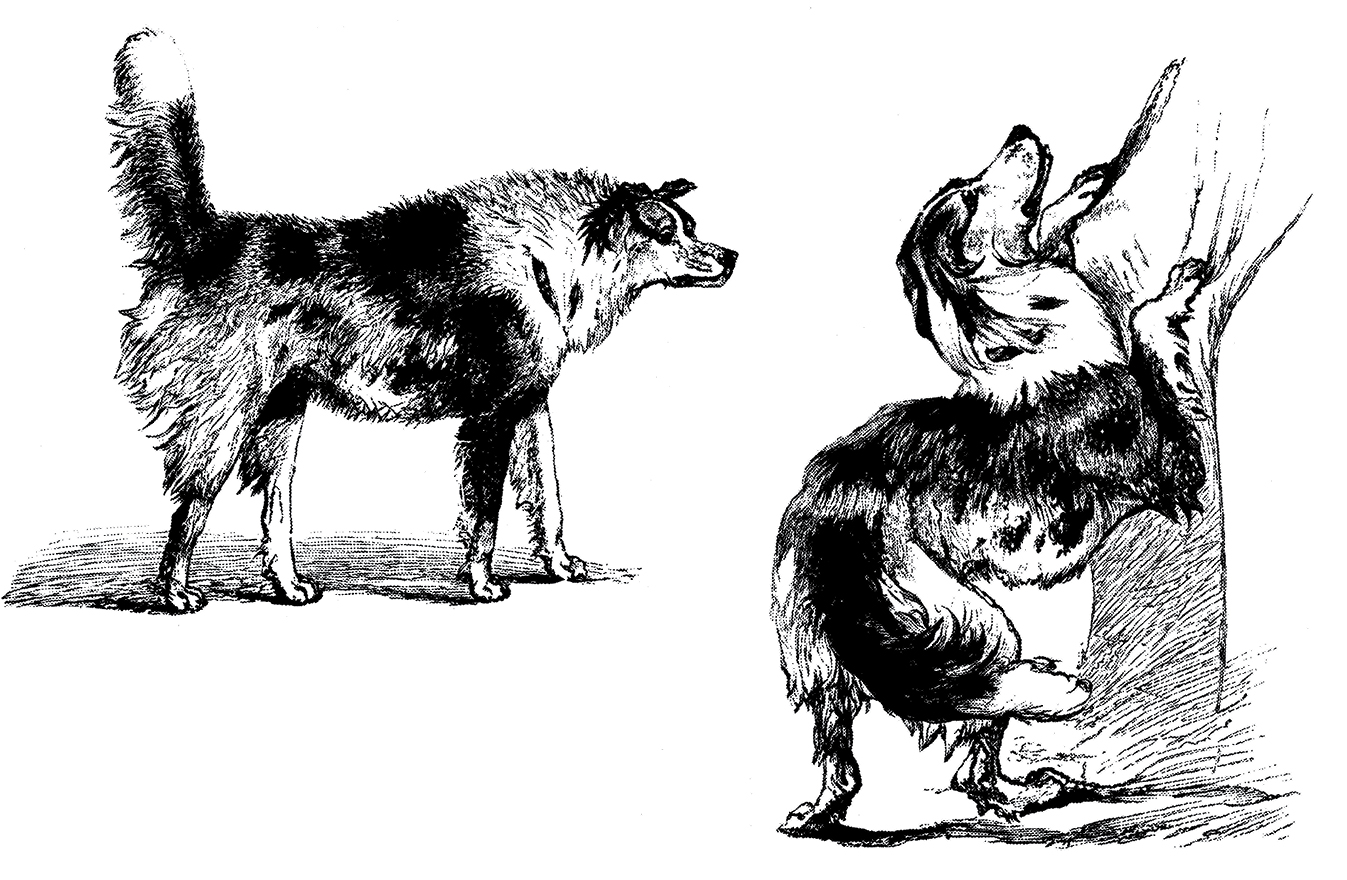
The Expression of the Emotions in Man and Animals by Charles Darwin was published in 1872. Darwin’s book is among the most enduring contributions to nineteenth-century psychology and a testament to his fascination with the dog. The left illustration is captioned, ‘Half-bred Shepherd dog approaching another dog with hostile intentions’. The right, ‘The same caressing his master’. Both were drawn by A. May. (Science History Images/Alamy Stock Photo)
One important strand was Darwin’s observations of the creation of new forms by deliberate breeding, which he referred to as artificial selection. His favourite examples were the extravagant strains of domestic pigeon created by fanciers, the main reason being that he was pretty certain that they all descended from just one wild species, the rock dove Columba livia. As in all his work, Darwin was thorough and meticulous. He kept the main varieties of pigeon himself at home, and through his network of contacts collected as many skins as he was able from far and wide. He spent days in the collections at the British Museum and even enrolled in two London pigeon-fanciers’ clubs.
As well as pigeons, Darwin studied pigs, cattle, sheep, goats, horses and asses, domestic rabbits, chickens, turkeys and ducks, even goldfish, not to mention plants of many kinds. And, importantly for us, dogs. The first chapter of his accumulated thoughts on evolution through artificial selection, published in 1868 as The Variation of Animals and Plants under Domestication, is devoted entirely to dogs.
Right at the start Darwin sets out the principal question surrounding the origin of dogs.
The first and chief point of interest in this chapter is whether the numerous domesticated varieties of the dog have descended from a single wild species or from several. Some authors believe that all have descended from the wolf, or from the jackal or from an unknown and extinct species. Others again believe, and this of late has been the favourite tenet, that they have descended from several species extinct and recent, more or less commingled together.
Then he adds: ‘We shall probably never be able to ascertain their origin with certainty.’
Darwin’s questions on the origin of dogs remained unanswered for over 120 years until the new science of molecular genetics began to take an interest. In the chapters that follow we will explore what this new science has to say about the evolution of dogs and how, for once, Darwin has been proved wrong. We have been able to ascertain the origin of dogs with certainty.
3
I Met a Traveller from an Antique Land
This is not the first time that I have hijacked this line from Shelley’s ‘Ozymandias’. It conveys perfectly the sense of antiquity and timeless continuity I still feel when I gaze at my favourite guide to the past – mitochondrial DNA.
To explain, we need to go back thirty years to a key paper published in the leading scientific journal Nature by the New Zealand-born evolutionary biologist Allan Wilson from the University of California, Berkeley.1 Wilson and his team had taken placenta or cell lines from 147 women from all over the world and isolated DNA from the mitochondria. Mitochondria are components of our cells that reside in the cytoplasm, that part of the cell that surrounds the cell nucleus but is still contained within the cell membrane. They are integral components of the cell, but they have their own separate origin. Back in the distant past they were free-living algae that became engulfed by a primitive cell and have remained there ever since. Being originally separate organisms, mitochondria still retain their own DNA. Their special property is that they enable the cell to use oxygen to burn food. Until then, cells only had the apparatus for anaerobic metabolism and could not cope with atmospheric oxygen. With the help of their newly acquired mitochondria, however, cells could squeeze up to nine times as much energy from the same amount of food. In the early atmosphere, oxygen was toxic but mitochondria turned it into the life-giving gas upon which every animal species depends upon today.
The other unusual feature of mitochondria is that they are inherited only through the female line. The reason is that animal eggs are crammed full of mitochondria, while sperm don’t have any to speak of. To be entirely accurate, those few they do have don’t survive in the fertilised egg. This was the feature that appealed to Wilson and his team. Everyone inherits their mitochondrial DNA from their mother, who got it from her mother, who inherited it from her mother and so on back through time. Males and females have mitochondrial DNA – after all they both need to breathe oxygen – but only females pass theirs on to their offspring.
In complete contrast to mitochondria, the DNA in the cell nucleus is inherited more or less equally from both parents. This nuclear DNA controls most of the body’s functions, with the important exception of aerobic metabolism, which remains the responsibility of the mitochondria and its DNA. Unfortunately, ancestral connections traced backwards by nuclear DNA soon become extremely complicated. We all have two parents, four grandparents, eight great-grandparents, sixteen great-great-grandparents and so on. The number of ancestors doubles with each past generation, so by the time we go back only twenty generations, that’s about four hundred years for humans, we have over a million ancestors. It’s very unlikely that we have inherited DNA from all of those thanks to the random mixing of nuclear DNA with each generation, something I shall explain later in the book. Even so, we will have inherited DNA from a great many of them, but from whom we will never know. In comparison with this genetic muddle, there was only ever one woman in each generation who is our mitochondrial ancestor and whose DNA we have inherited. It is that simplicity which drew Allan Wilson to investigate mitochondrial DNA (or mDNA for short) rather than nuclear DNA in his representative sample of the world’s population.
The striking conclusion of this work was that if you went back far enough, everyone on the planet has inherited his or her mDNA from just one woman. In ways that we will come on to, Wilson estimated that she lived in Africa about 200,000 years ago. Unsurprisingly, she was immediately dubbed ‘Mitochondrial Eve’. The results also showed a clear connection between Africans and everyone else, suggesting that modern humans spent a long time in Africa before some of them left to populate the rest of the world. It’s as well to remind ourselves here that we are only considering strict female–female matrilineal inheritance, with no consideration, for now, given to the DNA from men.
It was a delightfully simple conclusion, although some people still find it confusing. Eve was certainly not the only woman alive at the time, just the only one to have direct matrilineal descendants living today. As now, couples can have only sons or no children at all, but it is only daughters who can pass mitochondrial DNA to the next generation. It follows that in the 10,000 or so generations since Eve, the only mDNA to survive to the present day has been passed along unbroken matrilineal lines, while that from Eve’s many contemporaries has been eliminated at some point along the way.
Though there have been some modifications in the ensuing thirty years, this overall concept of Mitochondrial Eve has stood the test of time. Wilson’s 1987 paper became a model for all future molecular genealogies, which have completely revolutionised our view of human origins. I analyse mitochondrial DNA samples from all over the world, and marvel at every one of them. They have each travelled unseen for tens of thousands of years in the cells of a continuous line of ancestors from ancient times until today when, at last, they reveal their secrets in the laboratory.
It took ten years before the Los Angeles-based biologists Robert Wayne and Carles Vilà published an equivalent genetic analysis for the dog.2 Like Wilson, they used mitochondrial DNA, but with a more advanced technique that examined the DNA sequence itself rather than the limited summary that was all that had been available to Wilson a decade earlier. I will say more later on about DNA sequences, including what they are and how to read them, but for now we will concentrate on the dogs.
Wayne and his team collected an impressive set of samples. In addition to 140 domestic dogs from 67 different breeds, Wayne also included wolves, coyotes and jackals in his analyses. The wolf collection came to a total of 162 animals from 27 locations worldwide. In addition, because they had been mooted as possible ancestors of modern dogs, Wayne included 5 coyotes and 12 jackals – 2 golden, 2 black-backed and 8 simien. When the mDNA sequences from all these animals were displayed in a molecular tree (referred to as Wayne’s tree) in the same way that Wilson had portrayed the human mitochondrial genealogy, the resemblance between the two was clear to see.
Wilson’s human tree (see here) divided the world population into two main branches, one African and a second containing both some African and all the people from outside Africa before coalescing on a single matrilineal ancestor – ‘Mitochondrial Eve’. The Wayne dog DNA tree consisted of four main branches, each with a different, but still closely related, ancestor. Most dog breeds were placed in the major branch, which Wayne called branch I, and included many of the common breeds as well as some so-called ‘ancient breeds’ like the dingo, New Guinea Singing Dog, African Basenji and Greyhound. Branch II contained two Scandinavian breeds, the Elkhound and the Jämthund, while branch III included a variety of breeds such as the German Shepherd, Siberian Husky and Mexican Hairless. Finally, branch IV included Wirehaired Dachshund, a Flat-coated Retriever and an Otter Hound. This last branch also contained a few wolves, one of which, from Romania, was the only wolf in the whole study whose sequence exactly matched that of a number of dogs including a Toy Poodle, a Bulldog and, surprisingly, another Mexican Hairless.
The simplified diagram (see here) only shows the major mitochondrial groups. Within each circle are a number of breeds. They are not shown here but can be inspected in the original,3 where there are many examples of exactly the same mDNA sequence being found in several different breeds. For example, a Norwegian Buhund, a Border Collie and a Chow Chow had precisely the same mitochondrial DNA sequence. Equally, the same breeds could have different mDNA sequences and appear on different branches of the tree. For instance, the eight German Shepherds had five different sequences between them. We will consider what this means a little later.
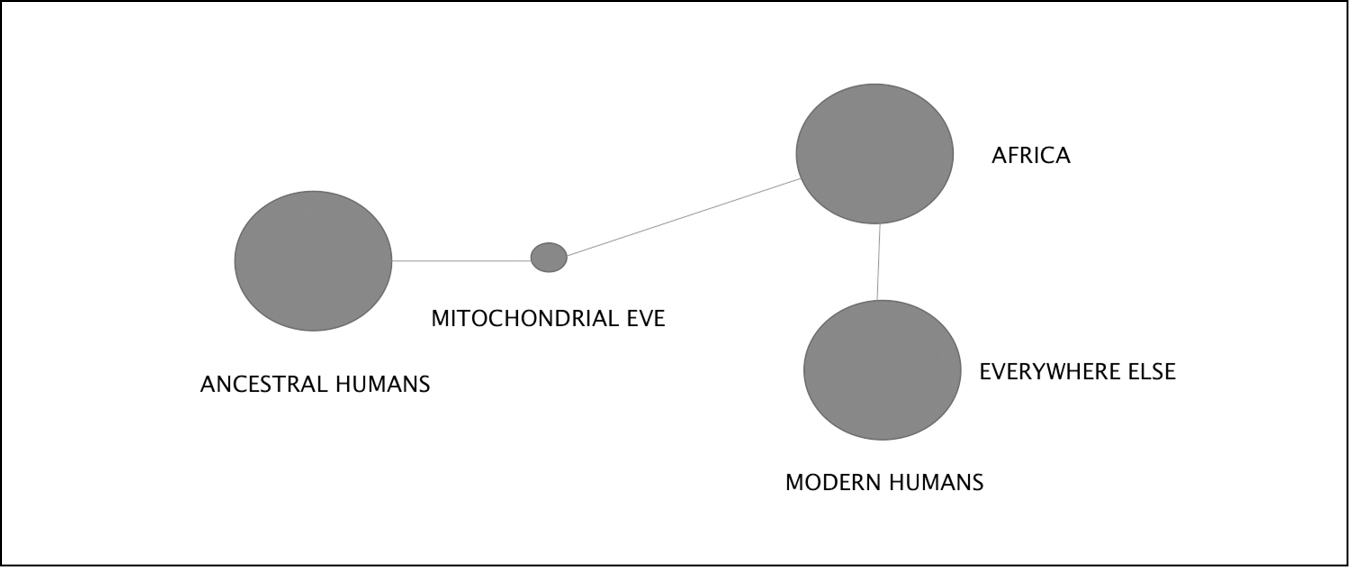
Wilson’s Human Tree (simplified). (Image courtesy of Professor Bryan Sykes)
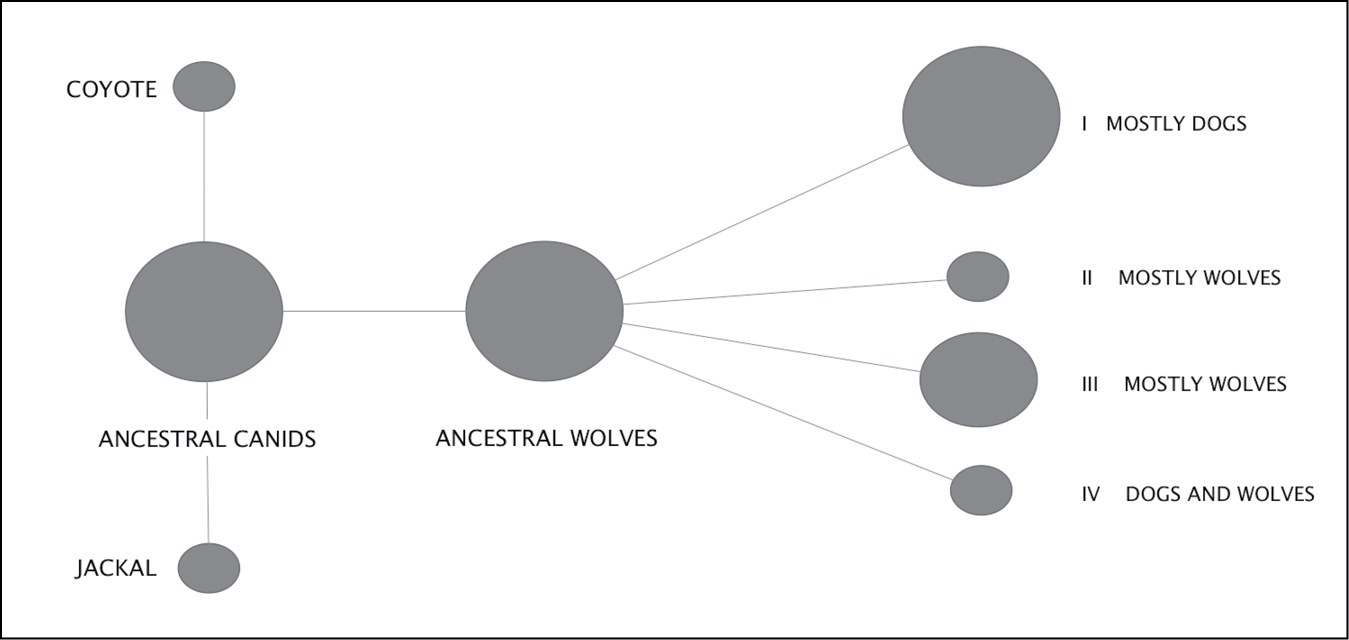
Wayne’s Dog Tree (simplified). (Image courtesy of Professor Bryan Sykes)
Had Darwin been alive to read it, he would have been itching to know where wolves, coyotes and jackals fitted into the tree, if at all. The answer was very clear. The coyote and jackal fell out of the main wolf/dog tree, as it were, immediately. Their DNA sequences were clearly quite different to all the dogs, and none made it into any of the four major branches. When it came to placing the wolf DNA sequences, the answer was equally striking, not because they were outside the dog tree but because they were deeply embedded within it. There was no doubt, from the mitochondrial DNA analysis, that all dogs were descended from wolves and from no other species. It was the first triumph of molecular genetics as applied to dogs – and by no means the last.
Darwin wasn’t wrong about much, but, by means he could never have foretold, his statement on dogs that ‘We shall probably never be able to ascertain their origin with certainty’ would turn out to be one of those rare exceptions. I am sure he would have been utterly delighted to be proved wrong.
Turn the clock forward another ten years to the present day and the Wayne dog tree is still alive. But, like the technical improvements we have considered in the decade between the Wilson and Wayne papers, there have been great strides in DNA analysis in the last ten years, which have led to some radical pruning of the original tree, while leaving the major branches intact.
Before we turn to the effect of these improvements in filling in the blanks in our knowledge of dog evolution there is one other important genetic system to consider. This is the Y-chromosome, the mirror image of mDNA in a genealogical sense in that it traces not the maternal but the paternal genealogy through time. Again the reason is simple enough. Only males have Y-chromosomes and they pass them on exclusively to their male offspring. In many species it is a less reliable witness than the mitochondrial equivalent because of the very variable mating success of males. In most species, including our own, males have the potential to father virtually unlimited numbers of offspring, or none at all, but females are restricted to just a few. This has major implications when we come to look at pedigree dogs.
Just as any conclusion about evolution based on mitochondria should carry the caveat that it can only reveal patterns based on females, so the Y-chromosome only traces the origins of males. Of course, ultimately they both have to tell more or less the same story, but there are fascinating twists and turns along the way.
In any sort of genetic analysis it is vital to be able to detect inherited variation, which is the lifeblood of genetics. Variation comes in many different forms – blood groups, hair colour, height or DNA sequence. You simply can’t do any genetics without it. For DNA the variation in sequence can be read directly, as it is for most mDNA comparisons, or it can use what are known as genetic markers. These are places where the sequence between, in this case, different Y-chromosomes, is known to differ. You can then test for the markers directly without having to sequence the whole chromosome, which saves a lot of time and money. But before you can use them you have to find them, which used to be an enormous bore. It is much better now, as we shall see.
The tedious process of discovering dog and wolf Y-chromosome markers was slow to get going and the first studies used a panel of only four markers. Luckily Y-chromosomes alone are spared the process of shuffling with other chromosomes, something else I will explain as we go along, and so the markers can be combined as blocks. So four markers (A–D), with two versions at each one (1 or 2), can differentiate sixteen Y-chromosomes (A1, B2, C1, D2; A2, B1, C2, D1 and so on), meaning that you can do a lot with just four markers and sixteen combinations.
A group from Sweden was the first to publish any wolf and dog results from this kind of analysis, having studied both Y-chromosomes and mitochondria in 314 dogs from 109 different pedigree breeds.4 Their wolves came from six different regions in Europe and North America, a total of 112 animals. And of course, for both dogs and wolves, all the animals were males. It came as no great surprise after the Wayne mitochondrial pattern (as illustrated here) to find that the dog and wolf Y-chromosomes were similar. Also, there was no sign of any other species, as was always a formal possibility when only the mDNA results were known. Had the original dogs been hybrids between female wolves and male jackals, for example, this would have been invisible to mDNA analysis but not to that of the Y-chromosome. The confidence that wolves really were the only ancestors of all dogs increased substantially after the Swedish study.
In a similar fashion to mDNA, the same Y-chromosome, as defined by its genetic markers, was to be found in several different breeds of dog. As an example, an identical Y-chromosome was found in a Bernese mountain dog, a Border Collie, a Dalmatian, a Greyhound, a Poodle, a Shetland sheepdog and a West Highland terrier. On the other hand, different individual dogs of the same breed often had several different Y-chromosomes. Five Collies, for example, were found to have three different Y-chromosomes between them.
The comparison of the male and female genetic contributions showed quite clearly that in domestic dogs there were many more different mDNA sequences around than there were different Y-chromosomes. What that meant became clear when the wolf results were compared. In wolves the number of different mDNA and Y-chromosome sequences was about the same, not skewed as in dogs. This is very familiar scenario in many human populations where there are lots of different mDNA types but fewer Y-chromosomes than there should be if breeding success was roughly equal across the sexes.
Wolves are almost entirely monogamous, with only one breeding male and one breeding female in a pack. As a consequence males and females make an equal overall genetic contribution to successive generations and, as the Swedish team found, this balances the mDNA and Y-chromosome diversity. In pedigree dogs, the situation is more like some human populations where a few males have a disproportionate number of offspring. The ultimate human example is Genghis Khan, the thirteenth-century Mongol emperor who has an estimated 16 million male descendants living today, each of them carrying his Y-chromosome. Genghis Khan achieved this feat by slaughtering his male enemies defeated in battle and inseminating as many women as possible, often to the point of exhaustion. ‘Try spending the night alone from time to time,’ his doctors cautioned. When he died in 1127 Genghis passed on his wealth, and his habits, to his sons. Male dogs can achieve similar breeding success with considerably less effort than Genghis Khan. All they have to do is win ‘Best in Show’ and let the breeders do the rest.
At first it was a puzzle as to why pedigree breeds showed little or no sign of a common origin, at least as far as mDNA and Y-chromosomes were concerned. Surely with all the care taken to make sure pedigree dogs breed true, all dogs within a breed should have the same origins along both male and female ancestral lines. Not so. Instead, there seemed to be no telling, short of DNA testing, to which mDNA or Y-chromosome branch any particular dog belonged. Certainly, the breed could not be predicted from the DNA results from either system.



